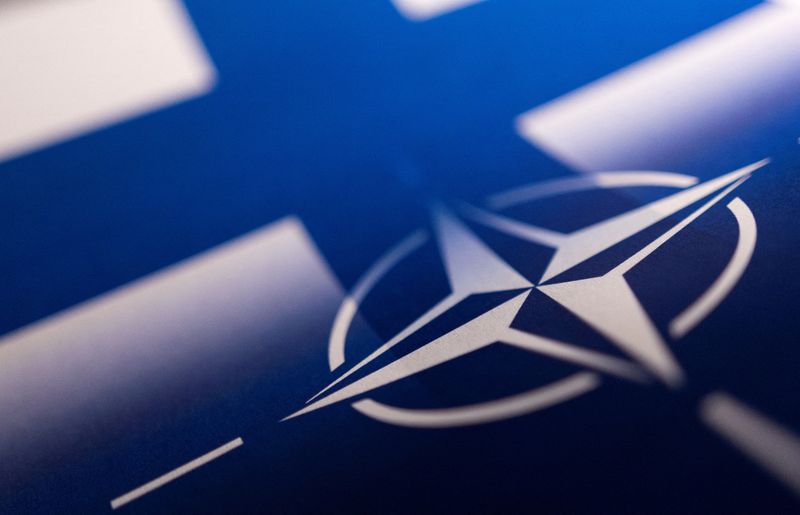STOCKHOLM (Reuters) - Russia's invasion of Ukraine has pushed Finland and Sweden to the verge of applying for NATO membership.
Finland, which shares a 1,300-km (810-mile) border with Russia, and Sweden will announce their decisions in the coming days amid warnings from Moscow it could deploy nuclear weapons and hypersonic missiles in the European exclave of Kaliningrad if they do.
Any applications will auger in a tense wait during the months it takes to be ratified by all NATO members, though the alliance and the White House have said they were confident any security concerns could be addressed in the interim.
Here are some of the issues that have led to a radical rethink of policy and what the next steps could be toward entering the 30-nation, U.S.-led alliance.
WHY ARE SWEDEN AND FINLAND NOT NATO MEMBERS?
- Both have been non-aligned since World War Two despite having small military forces, relative to Russia.
- Finland gained independence from Russia in 1917 and fought two wars against it during World War Two during which it lost some territory to Moscow. Finland signed an Agreement of Friendship, Cooperation, and Mutual Assistance with Russia in 1948, cementing a degree of economic and political dependency and isolating it militarily from western Europe.
- The end of the Cold War, bringing a break-up of the Soviet Union, allowed Finland to step out of Russia's shadow as the threat from Moscow diminished.
- It has relied on its own military deterrence and friendly relations with Moscow to keep the peace. But with Russia's invasion of Ukraine, which Moscow calls a "special operation", Russian President Vladimir Putin looks anything but friendly.
- Sweden has not fought a war for 200 years and post-war foreign policy has focused on supporting democracy internationally, multilateral dialogue and nuclear disarmament.
- It ran down its military after the Cold War, hoping in the event of any conflict it could delay a Russian advance until help arrived. Putin's offensive against Ukraine has made a guarantee of aid much more appealing.
- However, many on the left in Sweden remain suspicious of the U.S. security agenda and NATO, which ultimately relies on the deterrence provided by the U.S. nuclear arsenal.
- Both Finland and Sweden switched from formal neutrality to military non-alignment in 1995 when they joined the European Union.
- Both have drawn ever closer to NATO in recent years, exchanging intelligence and participating in alliance exercises, in response to an increasingly belligerent Russia.
- Joining the alliance would bring Sweden and Finland under the umbrella of Article 5, which guarantees that an attack on one NATO ally is an attack on all.
HOW BROAD IS SUPPORT FOR NATO MEMBERSHIP?
- Polls show a substantial majority of Swedes back joining NATO with support running just above 60% in the latest poll and there is a majority in parliament in support of an application.
- Sweden's Social Democrats - the biggest party and in power for most of the last century - has long championed military non-alignment but have been reviewing their objections with a decision on whether to join now due on Sunday. They are widely expected to back membership.
- The Swedish Left Party - formerly the communist party - remains against membership, as does the Green Party, but were the Social Democrats to change tack, that would create an overwhelming majority in parliament in favour.
- Opinion polls show support for membership in Finland has run even stronger than in Sweden with many Finns mindful of the long land border it shares with Russia while support in parliament for an application is also broad.
- The Finnish parliament's defence committee said this week that joining NATO was the best option for Finland to guarantee its national security.
- Finland's President Sauli Niinisto is expected to announce on Thursday his stance on joining NATO while Prime Minister Sanna Marin is also seen giving her views. Both are widely expected to come out in favour of applying.
WHEN COULD THEY JOIN?
- Finland has a NATO "option", a kind of a plan of action that mandates applying if the security situation deteriorates, while Sweden's parliament will present a new security policy review on Friday, though the latter is not expected to contain an explicit recommendation concerning NATO.
- Sweden's Social Democrats have called a parliamentary debate over NATO for Monday. Should the party as expected back joining, the government could call a Riksdag vote about sending through an application, but it is not formally required to.
- Social Democrat Prime Minister Sanna Marin, who heads Finland's five-party centre-left coalition, and President Sauli Niinisto have been touring different NATO member countries in recent weeks securing support for a potential application.
- Swedish Prime Minister Magdalena Andersson, also a Social Democrat, has likewise held scores of meetings with NATO governments, including with Britain's Boris Johnson who was touring both Sweden and later Finland on Wednesday.
- While there is no set time frame for the applications, here are the steps in NATO's membership process that would apply for Helsinki and Stockholm:
